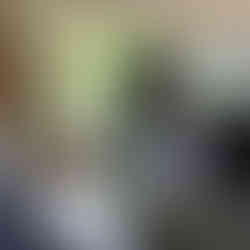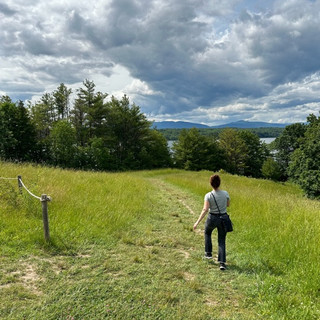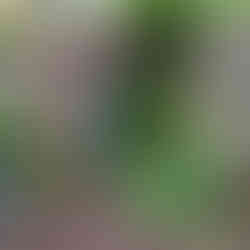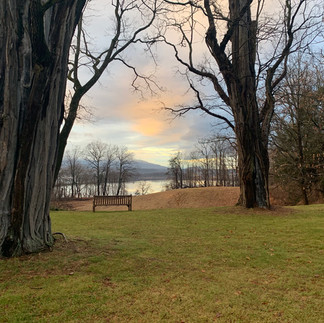
Novelist Jane Delury describes herself as a fledgling (maybe seedling?) gardener after 8 years into gardening being part of her everyday life and loves.
This labor and love in life coincides with themes of landscapes, gardens, and gardeners becoming fully-embodied motifs and characters in her fiction writing. They show up in her first novel-in-stories, The Balcony, and in her newly released novel Hedge, gardens, gardeners, and gardening past and present from all kinds of perspectives take center stage.
Jane was awarded the Sue Kaufman Prize for First Fiction from the American Academy of Arts and Letters for The Balcony.
Deep into the heat of the season now, it’s always gratifying to lean into the pleasures of a good summer book. In our case, a good garden-based summer book. Hedge is all that - a steamy, dreamy, and through the setting of gardens and garden history, the story plumbs the depths of human longing, loss, and ultimately the long view. Hedge was published by Zibby Books in June, and is one of those lovely stories that reinforces in fiction the importance and impact of gardens and gardeners of all kinds over time and space in real life. It’s also just a great story.
Jane joins Cultivating Place this first week of July to share more about her new and richly gardened novel, the research that went into it, and the garden passion and history that enlivens it. Listen in!
You can follow Jane Delury online at: www.janedelury.com/
and on Instagram: @Jane.delury/
HERE IS THIS WEEK'S TRANSCRIPT by Doulos Transcription Service:
IF YOU LIKE THIS PROGAM,
you might also enjoy these Best of CP programs in our archive:
JOIN US again next week, when we continue our summer vacation theme in conversation with Oklahoma gardener Linda Vater, whose Potager Blog and whose book The Elegant& Edible Garden are luxurious reminders that style and beauty have soothing and pleasing roles in our garden lives. That’s next week – listen in.
Speaking of Plants and Place back soon!
Cultivating Place is made possible in part by listeners like you and by generous support from
supporting initiatives that empower women and help preserve the planet through the intersection of environmental advocacy, social justice, and creativity.
Cultivating Place is also made possible through support from
Recent Garden Conservancy news includes the announcement of the second two episodes in the Sissinghurst through the seasons series – the Fall episode airing on Thursday September 21st and the Winter Episode airing on December 7th; as well as the announcement for the release of a new film trailer which highlights their forthcoming documentary about the Anne Spencer House and Garden in Virginia – the trailer and registration for the Sissinghurst series are both up at the Gardenconservancy.org now and the full Anne Spencer House & Garden documentary will be released later this year – should be excellent. And of course, registration is also now open for the Conservancy’s inaugural Garden Futures Summit being held at the New York Botanical Garden on Sept 29th and in gardens across NYC and surrounds on Sept 30th – can’t wait to gather then. Go to GardenConservancy.org for more information.
Thinking out loud this week:
Thinking about Jane’s novel, about the historic and life-filled gardens like Sissinghurst and the Anne Spencer Garden – these all bring questions to my mind like: What history, what stories, what narratives does the land of our gardens, our neighborhoods hold? Our narratives, past lives narratives?
I may have told you this story before, but the first garden and house I could call my own was a tiny bungalow in a northern neighborhood of Seattle. A neighborhood with a strong settler history and presence of Norwegian fisherfolk. The little house we bought as our first home back in the 1990s was a perfect brick block, house – just like the little boxes with pitched roofs that children make line drawings of, set right in the middle of its corner lot. It was a total of 800 square feet of house to almost 3 square feet of garden. We moved in in the winter.
To me the garden around the house felt a little disheveled, a little haphazard, I could identify the overgrown camellia at the back of the house, the overgrown rhododendron at the front, two clipped boxwoods at the side, but everything else looked like unintentional twigs. But as rainy winter turned to still rainy spring that year and the increasing light and warmth of the season built up, things started to break bud, and then bloom. I was a seriously love struck new garden tender (now I am a much older love struck garden tender) and I was out in that garden at first light and at last light, rain or shine as they say and in my mind I was working with a semi-blank slate as that saying goes, but nothing is a blank slate when it comes to the green mantle of the planet – not really, I know that now. And as the season progressed it became abundantly clear to me that the 90-something Norwegian widow, Mrs. Benson, whose passing had precipitated the sale of the house had been an experienced and loving garden tender before me, better than me. As winter turned to spring and spring to late spring and summer the twiggy mess at the side of the house turned into a gorgeous abelia, and those at the back of the house – out the main bedroom window unfurled into the most lush and fragrant native western philadelphus, which I was familiar with from the east but had never been able to garden with growing up in Colorado….I would quite literally walk around the garden and talk to Mrs. Benson: ahhh, nicely placed! I would say as I came across a new patch of bulbs emerging, or realize that the twiggy mess behind the small shed was in fact a beloved raspberry bed that fed us and eventually our first child throughout the summer months once I figured out the correct pruning of that type of cane.
The point of this reverie? And even how it relates to this conversation with Jane? We know each other better – we can understand one another and even ourselves better through the stories our gardens act out for us across time and space. Never forget it: how we tend the land shows us just who we are.
Happy July my friends – may your summer hold good books, great gardens, and leisurely garden enjoying for you.
WAYS TO SUPPORT CULTIVATING PLACE
Cultivating Place is a co-production of North State Public Radio, a service of Cap Radio, licensed to Chico State Enterprises. Cultivating place is made possible in part listeners just like you through the support button at the top right-hand corner of every page at Cultivating Place.com.
The CP team includes producer and engineer Matt Fidler, with weekly tech and web support from Angel Huracha, and this summer we're joined by communications intern Sheila Stern. We’re based on the traditional and present homelands of the Mechoopda Indian Tribe of the Chico Rancheria. Original theme music is by Ma Muse, accompanied by Joe Craven and Sam Bevan.
SHARE the podcast with friends: If you enjoy these conversations about these things we love and which connect us, please share them forward with others. Thank you in advance!
RATE the podcast on iTunes: Or wherever you get your podcast feed: Please submit a ranking and a review of the program on Itunes! To do so follow this link: iTunes Review and Rate (once there, click View In Itunes and go to Ratings and Reviews)
DONATE: Cultivating Place is a listener-supported co-production of North State Public Radio. To make your listener contribution – please click the donate button below. Thank you in advance for your help making these valuable conversations grow.
Or, make checks payable to: Jennifer Jewell - Cultivating Place
and mail to: Cultivating Place
PO Box 37
Durham, CA 95938




















